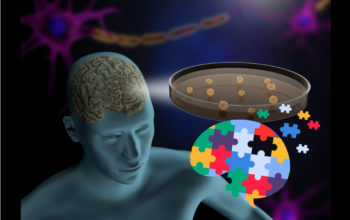
Date: 31st March 2022
There are just under 500,000 new cases of pancreatic cancer diagnosed every year. Compared with many other cancers, the combined five-year survival rate for pancreatic cancer is very low at just 5-10%. Pancreatic ductal adenocarcinoma (PDAC) is a highly metastatic disease and with tumours being poorly immunogenic and immunosuppressive, this prevents T cell activation in the tumour microenvironment rendering immunotherapies ineffective. Now, researchers have used a microbial-based immunotherapeutic treatment for selective delivery of an immunogenic tetanus toxoid protein into PDAC tumours by biohijacking Listeria.
Immunotherapy in different forms—checkpoint blockers, vaccines, and CAR T cells, for example—has had unprecedented success in halting or shrinking even advanced cancer in some patients. The largest and most-studied category of immunotherapy drugs is checkpoint inhibitors, antibody-based agents that mobilise the immune T-cell response. However, these work best on ‘hot’ tumours – cancers that have been invaded by T cells, creating an inflamed tumour. Pancreatic tumours are poorly immunogenic, and aren’t sufficiently ‘foreign’ to activate the immune system, due to their low mutational load and lack of effective neoantigens. In addition, the tumour microenvironment (TME) is immunosuppressive driven by myeloid-derived suppressor cells (MDSCs) and tumour-associated macrophages (TAMs) which prevents T cell activation in a cold tumour. To circumvent these issues researchers have been exploring multiple strategies that promote the transformation of cold tumours into hot ones which would lead to increased T-cell infiltration. However, an in depth understanding of the drivers and mechanisms of T-cell infiltration is required to develop these approaches.
Now, researchers at Albert Einstein College of Medicine, US, led by Claudia Gravekamp have solicited the help of Listeria monocytogenes to deliver highly immunogenic tetanus toxoid proteins directly into tumour cells. As the majority of people are already vaccinated against tetanus this delivery elicits an immune response, activating tetanus toxoid–specific memory T cells to kill the tumour cells. In an advanced PDAC mouse model the treatment reduced tumour burden by 80%, metastases by 87% and increased survival by 40% compared to nontreated mice.
The team had previously shown that Listeria attracts and infects MDSCs, which are then attracted to primary tumours through the production of cytokines and other factors. This is like delivering a Trojan horse to the TME, where the Listeria then infects tumour cells. Listeria bacteria are quite weak and are easily killed off by the immune systems of people and animals. However, the exception to this is in a cold tumour – where the immune system is suppressed giving Listeria enough time to infect cancerous cells. These characteristics make Listeria a highly suitable platform for the selective delivery of anticancer agents to the TME.
The team’s strategy capitalised on the childhood vaccinations programmes that see most children vaccinated against tetanus, a disease caused by a toxin protein from Clostridium bacteria. Tetanus-specific memory T cells, remain in the body for years, and upon an infection later in life will mount a strong immune response when exposed to the tetanus toxin.
To start the team developed a therapeutic Listeria able to produce the tetanus toxoid protein (Listeria-TT). This was able to infect cancer cells both in vitro and in vivo and the Listeria-TT was taken up by tumour cells within the TME of live mice models of pancreatic cancer. They found TT was secreted in ~80% of the primary tumour and were also found in the responding macrophages. Low doses of gemcitabine (GEM – a common chemotherapy medication) increased the immune effects of Listeria-TT, turning immunologically cold into hot tumours in mice.
Next, they asked whether Listeria-TT could reactivate preexisting memory T cells to TT in tumour-bearing mice. Here, they vaccinated young mice with TT vaccine two weeks before tumour development. They found that CD4 and CD8 T cells in mice that received the treatment were strongly activated compared to the controls. Listeria-TT + GEM turned immunologically cold tumours into immunologically hot tumours. CD4 memory T cells migrated to TME along with an accumulation of cytotoxic molecules such as perforin and granzyme B. The duo treatment altered the TME – decreasing the MDSC population which in tumours are more immune suppressive than in other tissues.
Finally, the team wanted to evaluate the therapeutic effect on pancreatic cancer using two different mouse models, which had been previously vaccinated against tetanus. In a peritoneal model of cancer the Listeria-TT +GEM treatment significantly reduced the size of the primary tumour by ~85% and metastatic tumour burden by ~89%. In the other advance PDAC model the tumour burden was decreased by ~80% and metastases by 87% after treatment and increased survival by 40% compared to nontreated mice. Further experiments determined that the CD4 T cells and not the CD8 T cells were responsible for reduction of the pancreatic cancer in vivo.
Conclusions and future applications
Then team here have demonstrated the effectiveness of a tumour-targeting attenuated Listeria, in combination with GEM, to deliver immunogenic TT protein, for the treatment of early and advanced pancreatic cancer in mouse models. This new strategy offers advantages of selective delivery of TT, now used as tumour antigen, in high abundance to the TME and inside tumour cells - altering the function of macrophages and MDSCs in the TME to promote immune stimulation, transforming cold tumours into hot ones.
The work here represents a promising new therapeutic strategy that needs further investigation in humans. With this in mind the underlying technology has been licensed to Loki Therapeutics, where Gravekamp is co-founder and principal scientist. One thing to note is that intraperitoneal injections were required for delivery of Listeria, if injected intravenously the bacteria were eliminated immediately. This is not a commonplace delivery method and is one that would likely require clinician training.
It is hoped that this approach will translate to other types of aggressive and hard-to-treat cancers such as ovarian cancer. Here to, recent advances have seen new therapeutic strategies improve tumour responses to immunotherapy by targeting critical drivers of the immune-suppressive TME in ovarian cancer. Others are finding new alternative ways to overcome cold tumours, such as finding key molecules that prevent immune cells from entering aggressive breast cancer tumours, or developing new types of therapeutic proteins such as engineered antibody-cytokine protein fusions, called immunocytokines, which convert the microenvironment of aggressive brain tumours into a proinflammatory phenotype promoting immune invasion and tumour regression.
Together, these innovative applications are starting to offer alternative treatments for hard-to-treat cancers, and offer to provide better outcomes for patients which currently have very few options.
For more information please see the press release at the Albert Einstein College of Medicine
Selvanesan, B.C., Chandra, D., Quispe-Tintaya, W., Jahangir, A., Patel, A., Meena, K., Silva, R.A.A.D., Friedman, M., Gabor, L., Khouri, O., et al. (2022). <i>Listeria</i> delivers tetanus toxoid protein to pancreatic tumors and induces cancer cell death in mice. Science Translational Medicine 14, eabc1600.
https://doi.org/10.1126/scitranslmed.abc1600
http://eha.3a7.mywebsitetransfer.com/new-therapeutic-approach-increases-effectiveness-ovarian-cancer-immunotherapy/
http://eha.3a7.mywebsitetransfer.com/new-target-aggressive-breast-cancer-blocks-immune-cells-infiltration/
http://eha.3a7.mywebsitetransfer.com/new-immunocytokine-therapy-shows-promise-glioblastoma/

